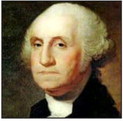The Presidents of the United States


1. George Washington: The founding father served as the first president of the United States from 1789-1797. Washington has been called the “Father of his Country” for his manifold leadership in the nation’s founding. He played an indispensable role in adopting and ratifying the Constitution of the United States. He was the only president to be unanimously elected. He also refused to accept his presidential salary, which was $25,000 a year.
2. John Adams: He was an American statesman, attorney, diplomat and writer. He was the only president elected under the banner of the Federalist Party. Adams signed the Alien and Sedition Acts and built up the Army and Navy in the undeclared naval war with France.
3. Thomas Jefferson: Jefferson was the principal author of the Declaration of Independence. As president, he promoted a western expansionist policy with the Louisiana Purchase which doubled the nation’s claimed land area.
4. James Madison:
Madison is hailed as the “Father of the Constitution” for his role in drafting and promoting the Constitution of the United States and the Bill of Rights. He presided over the creation of the Second Bank of the United States and the enactment of the protective tariff of 1816.
5. James Monroe:
Monroe was the last president who was a Founding Father. He issued the Monroe Doctrine, a policy of opposing European colonialism in the Americas. He helped negotiate the Louisiana Purchase.
6. John Quincy Adams: The eldest son of John Adams, he was the first president who was the son of a president. He called for an ambitious agenda that included federally funded infrastructure projects, but Congress refused to pass the projects. He also urged the United States to take a lead in the development of the arts and sciences through the establishment of a national university, the financing of scientific expeditions and the erection of an observatory.
7. Andrew Jackson:
In 1835, Jackson became the only president to pay off the national debt. He recognized the Republic of Texas. He survived the first assassination attempt on a sitting president.
8. Martin Van Buren:
Van Buren was the first president to have been born after the American Revolution and is the only president to have spoken English as a second language. Dutch was his primary language.
9. William Henry Harrison: He was the first of only three Whigs to become president. Just three weeks after his inauguration, Harrison fell ill and died days later in April 1841.
10. John Tyler: Tyler became the 10th President of the United States (1841-1845) when President William Henry Harrison died. He had several foreign policy achievements including the Webster-Ashburton Treaty with Britain and the Treaty of Wanghia with China. He signed a bill to offer Texas statehood just before leaving office.
11. James Polk: Often referred to as the first “dark horse” President, Polk was the last of the Jacksonians to sit in the White House and the last strong President until the Civil War. He achieved victory in the Mexican-American War, which resulted in Mexico’s cession of the entire American Southwest. He re-established the Independent Treasury system.
12. Zachary Taylor: Taylor became the first president to be elected without having previously held political office. The Clayton-Bulwer Treaty was ratified during his presidency. Taylor died suddenly of a stomach disease on July 9, 1850.
13. Millard Fillmore:
Fillmore took over the office after Taylor’s death. He supported U.S. Navy expeditions to open trade in Japan.
14. Franklin Pierce:
Pierce signed trade treaties with Britain and Japan and his Cabinet reformed its departments and improved accountability. His popularity declined in the Northern states after he supported the Kansas- Nebraska Act. The act’s passage led to violent conflict over expanding slavery in the nation’s West.
15. James Buchanan:
Buchanan intervened to assure the Supreme Court’s majority ruling in the pro-slavery decision in the Dred Scott case. He supported the Corwin Amendment in an attempt to reconcile the country. He was an advocate of states’ rights.
16. Abraham Lincoln:
Lincoln became the United States’ 16th President in 1861, issuing the Emancipation Proclamation that declared forever free those slaves within the Confederacy in 1863. His Gettysburg Address is regarded as one of the greatest and most influential statements of American national purpose. He won re-election in 1864. In his planning for peace, Lincoln was flexible and generous, encouraging Southerners to lay down their arms and join speedily in reunion. On April 14, 1865, just five days after the end of the Civil War, Lincoln was fatally shot.
17. Andrew Johnson:
Johnson implemented a series of proclamations to direct the seceded states to hold conventions and hold elections to reform their civil governments. He attempted to dismiss Secretary of War Edwin Stanton and ended up being impeached by the House of Representatives and narrowly avoided conviction.
18. Ulysses S. Grant:
In 1865, as commanding general, Grant led the Union Armies to victory over the Confederacy in the American Civil War. As President (1869– 1877), he worked to implement Congressional Reconstruction and to remove the vestiges of slavery. Grant stabilized the post-war national economy and supported Congressional Reconstruction. He created the first Civil Service Commission, advancing the civil service more than any prior president.
19. Rutherford B. Hayes: One of Hayes’ highlights was resolving the Great Railroad Strike of 1877 by calling in the U.S. Army. His policy toward western Indians anticipated the assimilationist program of the Dawes Act of 1887.
20. James Garfield:
Garfield advocated for agricultural technology, an educated electorate and civil rights for African Americans. Garfield led substantial civil service reforms through the Pendleton Civil Service Reform Act. Garfield was assassinated and he died on Sept. 19, 1881.
21. Chester Arthur:
Replacing Garfield, Arthur presided over the rebirth of the U.S. Navy. He advocated and enforced the Pendleton Civil Service Reform Act.
22. Grover Cleveland: Cleveland intervened in the Pullman Strike of 1984 to keep the railroads moving. He supported the gold standard.
23. Benjamin Harrison: Under Harrison’s leadership came the McKinley Tariff and the Sherman Anti-trust Act. Harrison facilitated the creation of the National Forest Reserves.
24. Grover Cleveland: Cleveland is the only president in American history to serve two non-consecutive terms in office.
25. William McKinley: McKinley presided over victory in the Spanish- American War and raised protective tariffs to boost American industry. He rejected the inflationary monetary policy of free silver and continued use of the gold standard.
26. Theodore Roosevelt: With the assassination of President McKinley, Roosevelt, not quite 43, became the 26th and youngest President in the Nation’s history. He led Congress and the American public toward progressive reforms and a strong foreign policy. He championed the Square Deal domestic policies that called for the breaking of bad trusts, regulation of railroads and pure food and drugs. He prioritized conservation and established national parks, forests and monuments.
27. William Howard Taft: Taft sought reductions to trade tariffs. After leaving office, Taft returned to Yale as a professor and worked against war through the League to Enforce Peace. He was appointed to be a Supreme Court Justice.
28. Woodrow Wilson: Wilson was the leading architect of the League of Nations. He issued the Fourteen Paints that the Allies and Germany accepted as a basis for post-war peace.
29. Warren Harding: An achievement for Harding came at the Washington Navel Conference when the world’s major naval powers agreed on a naval limitations program that lasted a decade.
30. Calvin Coolidge:
Coolidge signed the Indian Citizenship Act of 1924, which granted U.S. citizenship to all Native Americans. He was determined to preserve the old moral and economic precepts amid the material prosperity which many Americans were enjoying.
31. Herbert Hoover:
Son of a Quaker blacksmith, Hoover brought to the Presidency an unparalleled reputation for public service as an engineer, administrator, and humanitarian. The Great Depression dominated Hoover’s presidency and he attempted a series of economic policies in an attempt to improve the economy.
32. Franklin D. Roosevelt: He served from 1933 until his death in 1945, having been elected four times. He implemented the New Deal, which offered a variety of programs and defined modern liberalism in the United States. World War II ended in victory shortly after he died in office.
33. Harry S. Truman:
Truman became President when Roosevelt died. He presided over the onset of the Cold War in 1947. Truman, after consultations with his advisers, ordered atomic bombs dropped on cities devoted to war work. Two were Hiroshima and Nagasaki. Japanese surrender quickly followed. He oversaw the Berlin Airlift and Marshall Plan during 1948. He proposed comprehensive civil rights legislation.
34. Dwight D. Eisenhower: Eisenhower was a great foreign leader for the country. He condemned the Soviet invasion during the Hungarian Revolution. He worked to expand Social Security and signed the Civil Rights Act of 1957. Bringing to the Presidency his prestige as commanding general of the victorious forces in Europe during World War II, Eisenhower obtained a truce in Korea and worked incessantly during his two terms (1953-1961) to ease the tensions of the Cold War.
35. John F. Kennedy: Kennedy was the youngest person to assume the presidency by election. He signed the first nuclear weapons treaty. He presided over the establishment of the Peace Corps, Alliance for Progress and the continuation of the Apollo program with the goal of landing a man on the moon. He was assassinated on Nov. 22, 1963.
36. Lyndon Johnson:
Johnson’s Great Society program aimed to create better living conditions for low-income Americans. He signed the Social Security Amendments of 1965. His civil rights legacy was shaped by signing the Civil Rights Act of 1964.
37. Richard Nixon:
Nixon ended American involvement in the Vietnam War in 1973 and the military draft. He visited China in 1972 and established diplomatic relations between the two countries. He established the Environmental Protection Agency and began the War on Cancer.
38. Gerald Ford: Ford was appointed president after Nixon resigned. He presided during one of the worst economies in the four decades since the Great Depression. He signed the Helsinki Accords, which marked a move toward detente in the Cold war.
39. Jimmy Carter:
Carter pursued the Camp David Accords, the Panama Canal Treaties and the second round of Strategic Arms Limitation Talks. Carter created a national energy policy that included conservation, price control and new technology.
40. Ronald Reagan:
Reagan led economic deregulation and cuts in both taxes and government spending. He escalated an arms race with the Soviet Union. He worked with Soviet leader Mikhail Gorbachev to develop the Intermediate-Range Nuclear Forces Treaty.
41. George H.W. Bush:
Bush navigated the final years of the Cold War and played a key role in the reunification of Germany. He brought a dedication to traditional American values and a determination to make the United States “a kinder and gentler nation” in the face of a dramatically changing world. He presided over the invasion of Panama and the Gulf War.
42. Bill Clinton: He passed the Violent Crime Control and Law Enforcement Act. The nation reported a budget surplus for the first time since 1969. Clinton ordered U.S. military intervention in the Bosnian and Kosovo wars, eventually signing the Dayton Peace Agreement.
43. George W. Bush: Bush signed a major tax cut program. He pushed for socially conservative efforts such as the Partial- Birth Abortion Ban Act and faith-based initiatives. Bush ordered the 2001 invasion of Afghanistan and 2003 invasion of Iraq.
44. Barack Obama:
Obama presided over the implementation of the Affordable Care Act. He negotiated a nuclear agreement with Iran and normalized relations with China. He was the first person of color elected president.
45. Donald Trump:
Trump signed the Tax Cuts and Jobs Act of 2017, which cut taxes for individuals and businesses. His protectionist trade policies included tariffs in foreign aluminum, steel, and other products. The Trump administration also renegotiated trade agreements with Mexico, Canada, China, Japan, and South Korea. He appointed 54 federal appellate judges and three Supreme Court justices.
46. Joe Biden: Biden’s Inflation Reduction Act of 2022 covered deficit reduction, climate change, health care and tax reform. As a Senator from Delaware for 36 years, he established himself as a leader in facing important domestic and international challenges. He is widely recognized for his work while in the Senate writing and spearheading the Violence Against Women Act.















































